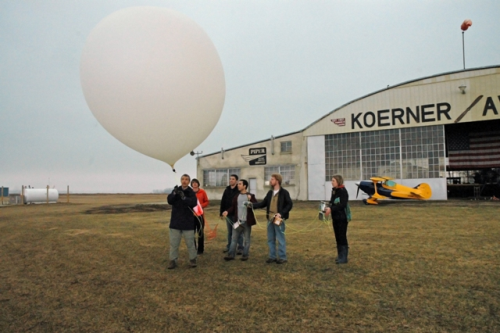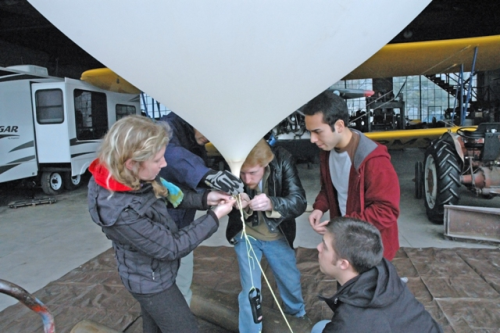Apr 02, 2009
DePaul Physics Students And Future Scientists From 14 Other Schools To Launch High-Altitude Balloons April 4
DePaul Physics Students And Future Scientists From 14 Other Schools To Launch High-Altitude Balloons April 4
DePaul University physics students and their counterparts at 14 colleges and universities around the country will take science experiments to new heights April 4 when they release high-altitude balloons into Earth’s atmosphere at 10 a.m. in
As part of the second annual High Altitude Launch Opportunity (HALO) Project, members of the DePaul Society of Physics Students will send a weather balloon to the edge of space from the Koerner Aviation Airport, 1520 S Route 115, Kankakee.
Fourteen additional balloons will be launched simultaneously by students at other universities throughout the
According to Bernhard Beck-Winchatz, assistant professor of astronomy in DePaul’s Scientific Data Analysis and Visualization Program, each student-launched balloon will include a global positioning system, ham radio,Geiger counter, and carbon dioxide temperature, humidity and pressure sensors.
The balloon network will collect multipoint data on climate change, promote science education and demonstrate an emergency communications system, according to a report from StratoStar System, a company that specializes in atmospheric data and a leader of the HALO II Project,.
The helium-filled balloons will soar to an altitude of 100,000 feet or 20 miles above the Earth to what is considered to be “near space,” before the lack of atmospheric pressure causes them to expand until they pop. Beck-Winchatz said it will take the balloons about 90 minutes to reach this height. After the balloons disintegrate, the scientific payload will descend back to Earth on a parachute in about an hour.
“The balloons are large to begin with, and they start off at a width of six to eight feet, but will stretch to as wide as 30 to 40 feet once they reach their maximum altitude,” he explained.
At least eight DePaul students will take part in the launch. Other schools participating are: Taylor University in Upland, Ind., which serves as lead school for the project; DePauw, Ball State, Southern Indiana and Valparaiso universities, also in Indiana; University of Wisconsin, University of Minnesota, College of St. Catherine (Minnesota), Wright State University (Ohio), Cedarville University (Ohio), Medgar Evers College (NewYork), Temple University (Pennsylvania), Bryan College (Tennessee) and Norfolk State University (Virginia).
The HALO II Project is funded by NASA’s Indiana Space Grant Consortium as a workforce development grant. Additional funding for DePaul’s balloon flight was provided by the Illinois Space Grant Consortium.

Physics students prepare to launch high-altitude balloon (photo by Jenny Gilbert).

Physics students prepare to launch high-altitude balloon (photo by Jenny Gilbert).
